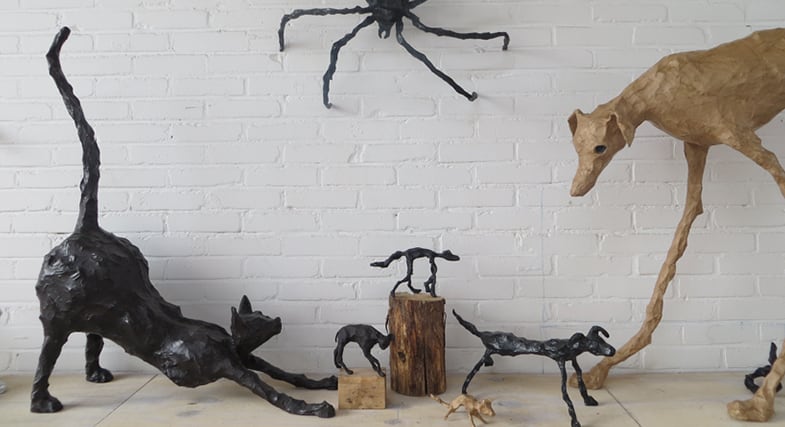How to create an environment that stimulates creativity
The right working environment can stimulate creativity and innovation. Colours, lighting, sounds and arrangement all influence how creative people are. However, the space in which you work is not the only thing that determines how creative your organisation is.
Our office cannot possibly be described as ordinary. If you were to walk around in the space where I write this article, you’d encounter picnic tables, lots of bamboo, a stuffed fox, paintings, animal sculptures, many meters of books, a large punching bag hanging from the ceiling and a lounge corner with a comfortable sofa and a chesterfield chair. We also tend to have a dog running around in the office…
Apart from the many objects and occasional canine you’ll encounter, you might stumble upon some very interesting professionals. We share our office building with a supplier of stunt cars, several set designers, a blacksmith, singers, architects, photographers, painters, a writer and a caterer.
All this not only makes it a fun place to work, but the curious environment actually makes perfect business sense. Unusual spaces tend to help spark creativity.

Some photos taken at the HatRabbits office
Inspiration
The most obvious advantage of the office I just described, is that all the unusual stuff lying around can be a source of inspiration. Stuff that is not related to your challenge is simply more likely to spark a creative idea. And in our office, we never have a shortage of ‘random stimulation‘.
Some managers would loathe the thought of having (stuffed) animals, artwork or other ‘distractions’ in the office. They might prefer a ‘clean desk policy’ over all this craziness. And they might be right …if the main tasks of the employees in that space are analytical. However, if you expect employees to come up with original ideas, you might want to reconsider a messy workspace.
Research has shown that messy environments stimulate creative thinking. The same study also finds that people in a disorderly room prefer options labelled as ‘new’ (whereas people who are in an orderly room tend to favour options that are labelled as ‘classic’).
Of course, an unusual and messy arrangement is not the only thing that influences the creativity of people. There are some other additions to the working environment that seem to stimulate creative ideas.
Background noise
Research shows that moderate and low levels of ambient noise enhance performance on creative tasks. One way of utilising this knowledge is by moving your work to the nearest café or restaurant. Luckily, websites like Coffitivity and Rainy Cafe also offer you the luxury of bringing that ambient noise to your own office.
Just enough light
It seems that to maximise people’s creativity, you should get rid of bright ceiling lights. Apparently, creativity spikes in dimly lit environments. The explanation: people subconsciously feel more free to ‘explore’ when a room is darker.
Creative colours
Curiously, experiments have shown that “a brief glimpse of green prior to a creativity task enhances creative performance”. The same has been said of blue. So if you want people to generate brilliantly original ideas, make sure there is enough green or blue around for them to gaze upon.
The office as a meeting place
The layout of your office building could determine how many ideas will be shared. By arranging the office in such a way that people run into each other more often, you can increase the chances of original ideas. For instance, Steve Jobs famously had the bathrooms in Pixar’s office put in the centre of the building. This way, he hoped to increase the number of “serendipitous personal encounters”. The best ideas are often a combination of insights from different people. The more people interact, the bigger the chances of stumbling upon brilliant ideas.

Curious animals at the HatRabbits office
Not enough
As helpful as all these examples of creativity-inducing offices are, an inspiring workplace is not enough. The location alone won’t lead to innovation. Other essential elements for an environment that leads to innovation are the right organisational culture, structure, commitment and implementation.
A culture that stimulates innovation
Culture is one of the main reasons why innovation does or does not work in an organisation. Are people afraid to share their ideas? Does management send the wrong message by failing to give the right example? Then it’s time to change some things drastically.
To establish a creative business culture, make progress visible, set clear goals (and break them down into manageable pieces), stimulate initiative, give teams the freedom to experiment, lead by example and show that you believe in your team.
Creativity needs structure
Another ingredient for an innovative organisation is structure. No great ideas come from chaotic sessions. By structuring the creative process, you’ll set up a fertile foundation for innovation. Use thinking techniques, work with strict time limits when generating ideas, start every brainstorm session with a Braindump and carefully evaluate the output.
Commitment
Just generating brilliant ideas is not enough. Someone has to take action to turn ideas into innovations. Many great ideas perish because nobody takes action. The solution? Making people commit to implementing the idea. A simple way to do this is by asking participants of a thinking session to sign an ‘idea contract‘.
A solid support base
One of the main problems for organisations that want to innovate is the lack of support for new ideas. If the people who are necessary for the implementation of an idea don’t believe in it, innovation will fail. To go from idea to innovation you’ll need to include everyone involved in the implementation of the idea. Let the board, (middle) management and workforce generate ideas TOGETHER. By connecting strategy, big business goals and small concrete solutions, you’ll generate innovative ideas with a solid support base.
What will be your first step towards an environment that stimulates creativity?





